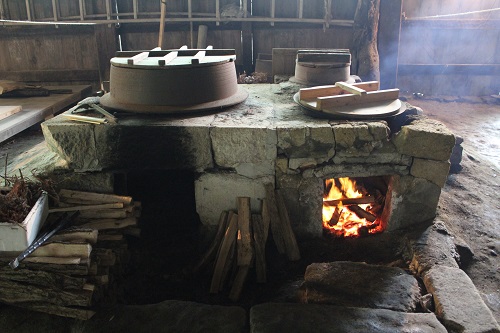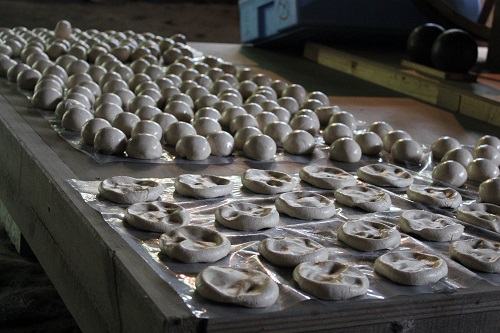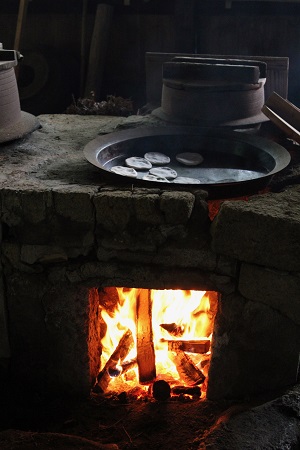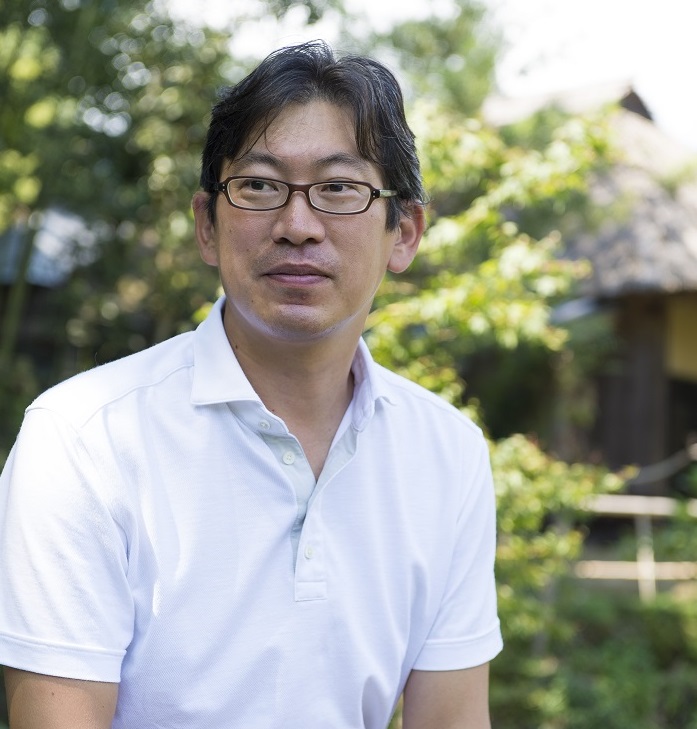"850 years of historical records" along with Nirayama reverberatory furnace that ought to be passed down to future generations. ~The long-awaited new storage warehouse is completed and it has encouraged preservation, restoration, and utilization~
Representative Director of Egawa Bunko non-profit incorporated foundation
The 42nd head of the Egawa Family
■The preservation of Japan’s oldest pictures taken by John Manjiro (Nakahama Manjiro)
Ms. Kato: There must be many valuable primary documents and cultural assets within the literary collection of Egawa residence managed by Egawa Bunko. How many are there?
Mr. Egawa: There are about 70,000 historical materials left after the Medieval Ages, of which about 40,000 have been designated as Important Cultural Properties. Most are ancient documents, but there are also many other calligraphy, book registers, ceramics, armors, weapons, and old photographs. In fact, it is thought that there may be more materials that are buried within the collection.
Ms. Kato: There are old photographs of those days left behind as well?
Mr. Egawa: Yes, out of those there are also ones taken by John Manjiro. John Manjiro once served as a salesclerk of the Egawa family. The pictures were taken with the photographic equipment he purchased when he revisited the United States.
Ms. Kato: Wow that is amazing! It is truly a treasure then. What kind of picture and when was it taken?
Mr. Egawa: There were pictures like a group photo of the samurai taken around 1860. It is pretty old for a picture taken by a Japanese.
Ms. Kato: It is probably the oldest! That is truly amazing. Are those valuable historical materials open for public viewing?
Mr. Egawa: In fact, the methods of preservation prior to its use has become a big issue. It is currently preserved inside a few old storehouses of the house. However, the storage environment is not great, so there are documents that have already been damaged. Therefore, we have been prioritizing the preservation of the collection these past few years, and we have finally completed the construction of a new repository this summer. It has just been made and so there are harmful substances emitted from the construction materials. Thus, it will be following next year that we will actually transfer the collection. From there, we plan to improve the restoration and create an environment that can be opened to the viewing of researchers in the future.
Ms. Kato: Along with the preservation of original materials, archiving the materials must have become an imminent goal. If not, the deterioration of the irreplaceable original historical materials will continue. It is Mr. Egawa’s critical mission to pass down records to the next generation then.
Mr. Egawa: You are right, as you said, we are going to proceed with archiving and provide these materials in a data-format as much as possible. We are struggling; we even have documents that can crumble by just opening it. In fact, we are at a stage where it took us 11 years to just complete the inventory, thus, the research has just begun. We have no idea if it will take hundreds of years to complete it.
Ms. Kato: The building of Egawa Residence itself is one of the Important Cultural Properties right? Nirayama is said to be the first place to bake a bread in Japan.
Mr. Egawa: It is not exactly the first place. Hidetatsu was interested in the Western bread as a preserved food for military provisions, so he sent a salesclerk to Nagasaki’s craftsman to learn the ways of its manufacturing. Moreover, he summoned Nagasaki’s craftsman and ended up actually baking one in the Egawa Residence of Nirayama. In honor of the day when bread was first made, April 12th is celebrated as “Bread Day” in Nirayama; on the weekend near this day, an event is held to bake bread with everyone in Egawa manor.
Ms. Kato: A bread made with the recipe from that time was being sold as a souvenir, so I bought it, but it was really hard. There are so many episodes and stories to be told.



Vol.60
Celebratory Message for the 10th Anniversary of the Inscription of "Site of Japan's Meiji Industrial Revolution" on the UNESCO World Heritage List
Representative Director, National Congress of Industrial Heritage
(Honorary Advisor, Kyushu Railway Company (JR Kyushu)
Vol.59
~The Appeal of Cultural Heritage as the Chief Researcher of the Industrial Heritage Information Centre~
Senior Researcher, Industrial Heritage Information Centre
Honorary Advisor, Nippon Mining Co., Ltd.
The Ambassador of Supporting Kamaishi Hometown
Vol.58
What is the value of World Heritage? - The viewpoint necessary to protect World Heritage sites is not to overlook what is essential.
Former Director of Nagasaki City World Heritage Office
Vol.57
Living now for the future of Japan: The mission of the Sites of Japan's Meiji Industrial Revolution is to raise awareness and courage that "Japan can be saved if we make use of the spirit of our predecessors."
Former General Manager, Nagasaki Shipyard and Machinery Works, Mitsubishi Heavy Industries, Ltd.
Vol.56
Japan's Meiji Industrial Heritage is the Pride of Japan - Knowing the Steps of Our Predecessors is the Key to Reconsidering Japanese Education
Chairman, Fujisankei Group
Executive Managing Advisor, Fuji Television Network, Inc.
Executive Managing Advisor, Fuji Media Holdings, Inc.
Vol.55
The Road to World Heritage Registration was Full of its Ups and Downs ~Blessed, Saved and Paved by the Luck of Human Fate~
Advisor, Federation of Japan Port and Airport Construction Association
(Ex. Chairman of Specialists Center of Port and Airport Engineering)
Vol.54
The historical flow of change from "Samurai to the Company" is the pride of Japan - Nagasaki, the center of Japan's Meiji Industrial Heritage Sites, will lead the way to connect to the next generation.
Vol.53
The Saga Clan Built Japan's First Reverberatory Furnace, and the "Mietsu Naval Station" was the Base of the Western-style Navy: Passing on the Passion That Went Into Registering the Site as a World Heritage Site to the Next Generation
Former Director of the Sano Tsunetami Memorial Museum (currently known as Sano Tsunetami and the Mietsu Naval Dock History Museum)
Vol.52
The Sites of Japan's Meiji Industrial Revolution is a "World Cultural Heritage" and a "World Evolutionary Heritage
Director of NPO Association for Thinking about Satoyama
Director of National Congress of the Industrial Heritage
Vol.51
Shoin Shrine has a mission to convey the history leading up to the Meiji Restoration properly
Honorary Chief Priest Toshinari Ueda
Vol.50
What is the secret plan to make the Port of Miike, an operational asset of a World Heritage site?
Former Mayor of Omuta City
Vol. 49
Why Conservation Management of Japan's Meiji Industrial Sites is needed?
Archaeologist and Heritage Conservation Specialist
Vol.48
The Truth of Industrial History Unraveled from the Perspective of Metallurgy: the Mission of the Heritage of Japan's Meiji Industrial Revolution is to Pass on the Intelligence, Diligence, and Fortitude of the Japanese People to Future Generations
A fellow of the Japan Federation of Engineering Societies
Professor Tadahiro Inazumi
Vol.47
The Sites of Japan's Meiji Industrial Revolution is a Great Teaching Aid, and Various World Revealed by Looking Into It
Team Member of the Industrial Project Team Office for the Promotion of World Heritage Listing under Cabinet Secretariat
Vol.46
The History of Iron that Began in Kagoshima has Dramatically Advanced Japan's Modernization~I Want to Pass on the Vitality of the People of Satsuma to the Younger Generations Whom Will Live in the Future~
Governor of Kagoshima Prefecture
Vol.45
Yoshida Shoin preached the Theory of Engineering Education and produced the Choshu Five who risked their lives to go to England--to pass on the proud Hagi spirit to future generations
Vol.44
I wish to pass on to my children's generation the wisdom, technology, and energy of our ancestors who built Misumi West Port - I will do my very best to do what I can at this moment by looking ahead to the future that will surely come after COVID-19.
Mayor of Uki City, Kumamoto Prefecture
Vol. 43
An Imperial Company named the Yawata Steel Works became a World Heritage Site from a Single Old Photo!
The Former Employee of Nippon Steel Corporation
Vol.42
We would like to Establish a "New Local Studies" that will be transmitted to the Outside World.
An Associate Professor of the Faculty of Science and Engineering in Iwate University
Vol.41
18 Years History of a Tourist Guide Business and an Outpouring of "Love for Misumi West Port." ~"Registration for World Heritage is Not Simply a Goal, but a New Starting Point."~
Chairman of the Tourist Guide Association of Misumi West Port
Vol.40
To Mark the Passage of "Time" Together with Nirayama Reverberatory Furnace ~To increase the attractiveness of "reverberatory furnace tourism" through the use of commercial museum and restaurant business~
President of Kuraya Narusawa Co., Ltd.
Chairman of Izunokuni City Tourism Association
Vol.39
The Establishment of the Gunkanjima Digital Museum Were Led by Fate: I want to start, continue, and finish what I can do to convey the value of the Sites of Japan's Meiji Industrial Revolution to a wide audience
Director and General Manager of Gunkanjima Concierge
Producer of the Gunkanjima Digital Museum
Vol.38
In Industrial Heritage, It's the "People" Who Play the Central Role: How World Heritage Inscription Casts a Fresh Light on Hometown Splendors
Vol.37
Everything is for the Economic Development of Nagasaki--Expanding Beyond the Shipping Business to Pass on Nagasaki's Culture and Industrial Heritage
Chairman: Mr. Hidenori Date
President: Mr. Masahiro Date
No.36
Kamaishi's "Miracles" and Overcoming Disaster: The Huge Opportunity Provided by World Heritage Site Inscription
Proprietor, Houraikan Inn
Vol.35
"850 years of historical records" along with Nirayama reverberatory furnace that ought to be passed down to future generations. ~The long-awaited new storage warehouse is completed and it has encouraged preservation, restoration, and utilization~
Representative Director of Egawa Bunko non-profit incorporated foundation
The 42nd head of the Egawa Family
Vol.34
The History of an Era Opened by an Indomitable Pioneering Spirit and the Power of Our Forefathers
Democratic Party for the People (DPP) Representative for Nagasaki Prefecture
Vol.33
Gunkanjima Is a Warning Message for the Future of Earth and Humanity ~The Thoughts and Pleas of a Guide and Former Resident~
President of the NPO, Way to World Heritage Gunkanjima
Vol.32
Synchronicity Yields the Miracle of World Heritage Site Inscription: Strong Aspirations Inspire Support among Like-Minded Individuals
Representative Director
MI Consulting Group
Vol.31
Power to the People of Japan The Mission of Meiji Japan's Industrial Revolutionary Heritage
President of Watanabe Production Group and Honorary Chair of Watanabe Productions Co., Ltd.
Vol.30
Turning Our Industrial Heritage into Hope for Those 100 Years From Now
Member of the House of Councillors
Vol.29
Calling on 21st Century Satsuma Students to Build the Future! Shuseikan Serves as a Source of Information about Sightseeing in Kagoshima
Governor
Kagoshima Prefecture
Vol.28
Awareness of "Stories with Connections" is steadily spreading throughout each region~There are also challenges for conservation management and interpretation~
World Heritage Consultant
Vol.27
Where There Is a Will, There Is a Way: Connecting with People Takes Courage and Initiative
Director and Dean, The Kyushu-Asia Institute of Leadership
Representative Director, SUMIDA, Inc.
Vol.26
Taking Pride in Japan's Latest World Heritage Sites~A Journalist's Perspective~
Journalist, founder of the Shimomura Mitsuko Ikikata Juku School
Vol.25
Classic Cars and the Sites of Japan's Meiji Industrial Revolution~Rally Nippon 2019 in Kyushu~
Representative, Rally Nippon
Vol.24
Preparations Proceed for the Development of Exciting Touring Routes to See the World Heritage Sites - The Promotion Council Conveys their Attractions to the World through Various Promotions!
Chairman, Sites of Japan’s Meiji Industrial Revolution World Heritage Route Promotion Council Director, National Congress of Industrial Heritage
Vol.23
Giving Greater Force to the Preparation of Routes toward Promoting "Heritage Tourism" - Recollections of the Unforgettable Bombing of Hometown Kure City and the Hiroshima Atomic Bomb
Representative Director, General Incorporated Foundation National Congress of Industrial Heritage (Advisor, Public Interest Incorporated Foundation Capital Markets Research Institute)
Vol.22
The City Connected to the World: Making the "Treasure of Nagasaki" the "Treasure of the World"
Vol.21
"The World's Experimental Facility" that Questions of the True Value of the "ICOMOS-TICCIH Cooperative Principles" New Conservation Challenges Promoted by the Japanese Government
Policy Director at Heritage Montreal
Vol.20
Days of Heated Argument with the Unforgettable Stuart Smith~A Cross-Cultural Encounter with Familiar 19th-Century Industrial Heritage~
World Heritage Consultant
Vol.19
The next generation of technological innovation is born from carrying forward history and culture. - Sites of Japan's Meiji Industrial Revolution open the way to "conserving while using"
Executive Director of Kogakuin University
Vol.18
Blazing a New Trail for Serial Inscription-Format Conservation and Management with the Sites of Japan's Meiji Industrial Revolution: Training Personnel to Pass on Memory and Understanding as a Major Challenge in the Future
Heritage Architect and International Consultant
Vol.17
3D Digital Documentation of the Giant Cantilever Crane and Kosuge Dock
Head of Data Acquisition at The Glasgow School of Art’s School of Simulation and Visualisation
Vol.16
Japan's Uplifting Industrial Heritage
Head of Industrial Heritage, Historic Environment Scotland, Edinburgh
Vol.15
The Scottish Ten Project
Scottish Ten Project Manager, Historic Environment Scotland, Edinburgh
Vol.14
The Tea Plantation Hill Where You Can See Two World Heritage Sites at Once, Mt. Fuji and the Nirayama Reverberatory Furnaces--The Next Dream Is a "Mini Reverberatory Furnace for Children" to Provide Experiential Learning
Mayor of Izunokuni City, Shizuoka Prefecture
Vol.13
Path to becoming a World Heritage Site
Pro-Provost and Chairman of Council of the Royal College of Art. Heritage advisor of Canal & River Trust for England and Wales.
Vol.12
In the midst of accurate information dissemination, it created a chance to truly look at history
Dean of Tokyo Rissho Junior College
Professor emeritus of Keio University
No.11
World Heritage Inscription Spurs Renewed Civic Pride in Kitakyushu's Industrial Heritage
Vol.10
World Heritage Inscription: Report on the 2015 Celebratory Party Held in Bonn, Germany
At the 39th session of the World Heritage Committee convened in Bonn, Germany, from June 28 to July 8, 2015, the decision was approved to inscribe the Sites of Japan’s Meiji Industrial Revolution on the World Heritage list.
At a celebratory party held to mark the occasion, some of the primary promoters of the project spoke of their joy in achieving their goal and of the trials and tribulations to getting there.
Background of World Heritage Inscription
Vol.9
Conserve and Use: Pioneering New Approaches for Operational Heritage Assets
Director and Managing Executive Officer, Hanshin Expressway Company Limited
Member, Board of Directors, National Congress of Industrial Heritage
Vol.8
Applying Port and Harbor Act Provisions to Conserve Operating World Heritage Sites
Vice-Governor of Shizuoka Prefecture
Vol.7
The Choshu Five: Pioneers of Modernization and Hagi's Heritage of Trial and Error
Vol.6
The Sites of Japan's Meiji Industrial Revolution: The Roots of Japanese Craftsmanship and Industry
Chairman, Tokyo Metro Co., Ltd.
Vol.5
The Miike Area: How Coal Contributed to Japan's Modern Industrialization
Vol.4
The Meiji Industrial Revolution: A Story of Broad Vision and a Strong Sense of Mission to Undertake New Challenges for the Good of the Nation and its People
Deputy Director-General, Lifelong Learning Policy Bureau, MEXT
Former Counsellor, Cabinet Secretariat
Vol.3
From Kamaishi to Yawata: The Proud Heritage of Japan's Modern Iron Industry
Vol.2
Lord Nariakira Shimadzu's Shuseikan and the Efforts to Build a Strong and Affluent Nation
Member, Board of Directors, National Congress of Industrial Heritage Counselor, Shimadzu Limited
Vol.1
The Genesis of Japan's Rise as an Industrial Nation: Preserving the Sites of Japan's Meiji Industrial Revolution for Future Generations
Chairman of the Consortium for the World Heritage Inscription of Modern Industrial Heritage (Kyushu-Yamaguchi) and governor of Kagoshima Prefecture (as of 2015)



